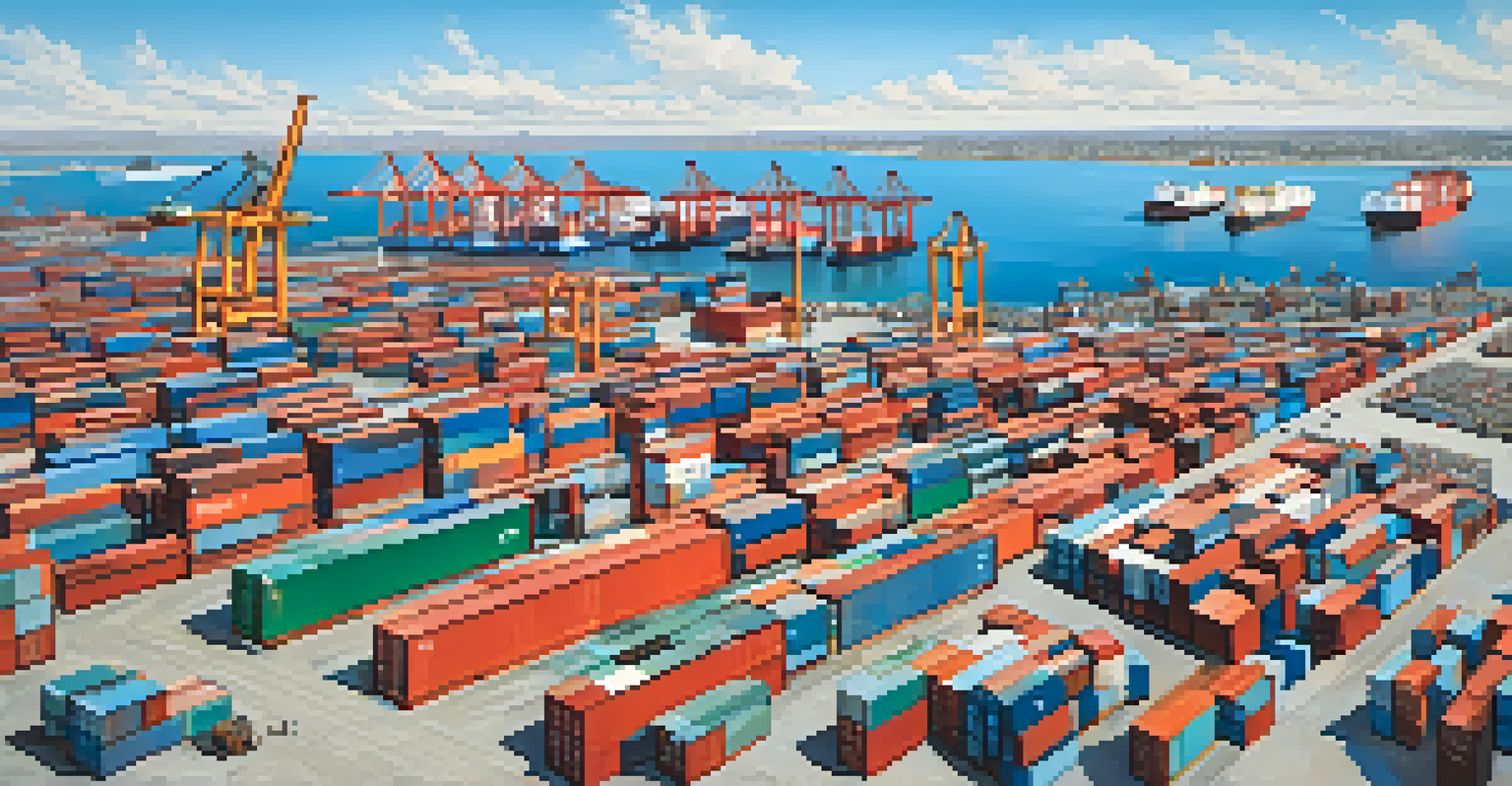California's Ports: Crucial Gateways for Global Trade Dynamics

Introduction to California's Strategic Importance in Trade
California's ports are not just gateways; they are vital arteries of global trade. With the Pacific Ocean at its doorstep, the state serves as a key entry and exit point for goods traveling between Asia and North America. This strategic location has made California a critical player in the world of international commerce.
Trade is the lifeblood of the global economy, and ports serve as the arteries that transport that lifeblood.
The ports of Los Angeles and Long Beach, in particular, handle a significant portion of container traffic, making them among the busiest in the United States. Their efficiency and capacity to manage large volumes of cargo significantly bolster the state's economy and contribute to national trade dynamics.
As the global economy evolves, California's ports continue to adapt, embracing new technologies and practices. This evolution is essential for maintaining their competitive edge and ensuring they meet the ever-increasing demands of global trade.
Economic Impact of California's Ports on Local Communities
The economic ripple effect of California's ports is profound, impacting local communities in various ways. Thousands of jobs are directly tied to port operations, from longshoremen to logistics managers, creating a robust employment ecosystem. This influx of jobs stimulates local economies, supporting businesses ranging from restaurants to retail.

Moreover, the ports contribute significantly to tax revenues, which fund essential services such as education and infrastructure. This financial boost is particularly vital for communities surrounding the ports, enhancing their quality of life and economic stability.
California's Ports Are Trade Arteries
California's ports serve as vital gateways for global trade, linking Asia and North America and significantly impacting the economy.
Additionally, the ports foster international trade relationships that bring diverse goods and services to local consumers. This not only enriches the community's cultural fabric but also provides access to a wider range of products at competitive prices.
Technological Innovations Transforming Port Operations
Technological advancements are revolutionizing how California's ports operate, enhancing efficiency and reducing congestion. Innovations like automated cranes and real-time tracking systems streamline the loading and unloading processes, minimizing wait times for ships. This increased efficiency is crucial in a world where time is money.
Sustainability is no longer a choice; it is a necessity for the future of global trade.
Furthermore, the adoption of green technologies is helping ports reduce their environmental footprint. Initiatives like electrification of cargo handling equipment and the use of renewable energy sources are paving the way for more sustainable operations, aligning with global efforts to combat climate change.
These technological strides not only improve the ports' operational capacity but also enhance their competitiveness on a global scale. As other ports worldwide look to emulate California's success, these innovations set a benchmark for the future of maritime trade.
Challenges Facing California's Ports in a Global Economy
Despite their strengths, California's ports face numerous challenges that could hinder their efficiency and growth. Issues such as port congestion and labor disputes can create bottlenecks, affecting the timely delivery of goods. These challenges highlight the need for continuous improvement in operational practices.
Additionally, competition from other ports along the West Coast and beyond is intensifying. As ports in neighboring states invest in their infrastructure and technology, California must remain vigilant to retain its status as a premier trade hub.
Jobs and Community Growth from Ports
The ports generate thousands of jobs and contribute to local economies, enhancing the quality of life for surrounding communities.
Moreover, global events like pandemics or geopolitical tensions can disrupt supply chains, impacting port operations. The ability to adapt to these unpredictable challenges is vital for the continued success of California's ports in the ever-changing landscape of global trade.
The Role of California's Ports in Environmental Sustainability
California's ports are increasingly prioritizing environmental sustainability, recognizing their role in the broader ecological landscape. Initiatives aimed at reducing emissions and improving air quality are becoming integral to port operations. For instance, the ports have committed to using cleaner fuels and investing in electric vehicles for cargo transport.
These efforts not only benefit the environment but also enhance the ports' reputations among environmentally conscious consumers and businesses. By leading the way in sustainable practices, California's ports position themselves as models for others to follow in the global shipping industry.
Furthermore, partnerships with environmental organizations and local communities are fostering a collaborative approach to sustainability. This collective effort is crucial for developing innovative solutions to environmental challenges while maintaining efficient trade operations.
Future Trends Shaping California's Ports and Trade
As we look ahead, several trends are likely to shape the future of California's ports and their role in global trade. E-commerce growth is driving demand for faster shipping and more efficient logistics, prompting ports to adapt their operations accordingly. The rise of direct-to-consumer shipping models is also influencing how goods move through these crucial gateways.
Additionally, the push for digital transformation is expected to continue, with more ports integrating technology into their logistics and management systems. This shift will facilitate better data sharing among stakeholders, enhancing collaboration and decision-making processes.
Sustainability Drives Future Port Trends
California's ports are prioritizing environmental sustainability and technological innovations to maintain their competitive edge in global trade.
Moreover, as climate change becomes an increasingly pressing issue, California's ports will likely play a key role in promoting sustainable trade practices. By embracing green technologies and practices, they can lead the charge toward a more sustainable global shipping industry.
Conclusion: The Indispensable Role of California's Ports
In conclusion, California's ports are indispensable to the dynamics of global trade. They not only serve as critical gateways for goods but also significantly contribute to the state's economy and local communities. The ongoing evolution of these ports reflects the changing landscape of international commerce and the need for continuous adaptation.
As challenges arise and new trends emerge, the focus on technological innovation and sustainability will be vital for their future success. By addressing these areas, California's ports can maintain their competitive edge and ensure they remain at the forefront of global trade.

Ultimately, the story of California's ports is one of resilience and transformation, showcasing their essential role in shaping the future of trade not just in the U.S., but around the world.